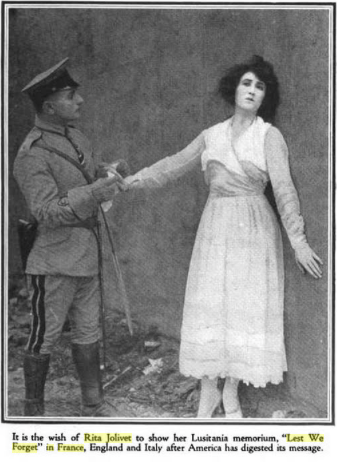
One hundred years ago this week, actress Rita Jolivet was making plans to travel with her upcoming film, Lest We Forget. It wasn’t an ordinary promotional tour:
Miss Jolivet proposes to show the film in all the large centers of military occupation behind the French front. This will include the camps of the American troops as well.
But her plan wasn’t the main reason the story was headlined “Rita Jolivet is Brave.” That was because she’d survived the Lusitania sinking, and she was willing to cross the Atlantic again in wartime. Despite her intentions, that tour never happened, according to passenger records (she next sailed to Europe in 1921). Instead she toured the United States with the film in early 1918, helping to sell war bonds as well as the film.
What’s unusual is that she played a Lusitania survivor in the film, too. They recreated the sinking for it, which must have been disturbing to relive. She didn’t mention any trauma; instead the press releases said she offered her expert guidance to the director.

I was taught in history class that the sinking wasn’t one of the reasons the United States entered the war because it happened two years before the war declaration, but the publicity for Lest We Forget shows that it was used to remind people why they fought. On July 7, 1918 the LA Times ran the headline “Charging Americans crying ‘Lusitania!’ spread terror among the Huns south of the Somme,” so it certainly wasn’t forgotten. The film has been preserved at the Eastman House and the Library of Congress.
Even now it’s not forgotten: I was surprised by how many people have blogged about Jolivet and the Lusitania. If you’d like to know more about Rita Jolivet visit The Lusitania Resource or Rita Jolivet, Unsinkable.
Kingsley’s favorite film this week was The Mysterious Mr. Tiller, which she thought was “the best film of the detective sort since Sherlock Holmes.” She wrote “the story keeps you sitting right on the edge of your seat every minute…you never quite catch up, until the breathless last ten feet.” Ordinarily she was happy to tell everything about a film’s plot, but she liked this one so much that she refused to spoil it. Other writers were less reticent, so since it’s a lost film, I’ll tell you: it turns out that the glamorous woman (Ruth Clifford) is an undercover agent and “The Face,” a master criminal, is actually Prentice Tiller (Rupert Julian), the chief of the Secret Service! And yes, they do recover the stolen necklace.
Roscoe Arbuckle was “arousing his customary roars of merriment at the Garrick this week,” with his new two-reeler Oh Doctor. Kingsley reported on exactly what the audience laughed at the most: “when Fatty, knocking at a door a long time, grows bored, looks away, but keeps on knocking even when his blows fall on the chest of a young lady who opens the door.” However, Kingsley’s favorite bit was the trick automobile that hits pedestrians, furnishing new patients for the doctor. To find out what someone thinks now, read Lea’s recent review at Silent-ology. The short is available on DVD.
Kingsley gave Theda Bara a sort of exit interview this week. The star was about to return to New York City, and she said many complimentary things about California and her beautiful garden. She did have one complaint: “I should have loved the thrill of an earthquake – just a tame one, of course. I didn’t ask for anything spectacular.” As a librarian, I really must disagree with her – even little earthquakes are only thrilling if you enjoy picking up books.
A vaudeville psychic, Leona LeMar (“the girl with a thousand eyes”), visited a film set at Universal City. To test her abilities, the star, Carmel Myers, asked her what the picture was about. “Miss LeMar passed her hand over her eyes, made a few motions in the air and finally answered: ‘well, I don’t know enough about pictures to answer that one.” Scotty Dunlap, the assistant director, promptly answered, “why that’s all right. We don’t know ourselves!”
That sounds like someone trying to politely put a guest at ease until you read the AFI Catalog’s plot summary for the film, The Lash of Power. That now lost film was so weird, it’s no wonder they didn’t know. Enjoy:
John Rand, having lived in a small town his entire life, dreams of possessing wealth and power in New York. Napoleon Bonaparte has long been his ideal, and one day he feels a message from the departed general urging him to take up the fight for world supremacy. He goes to the city ready to begin the battle, and there, aided by his Napoleonic visions, John amasses a great fortune, ruthlessly destroying everyone who presents an obstacle to his lust for power. His ambitions satiated, John becomes the enemy of democracy when he sells a secret formula to an enemy power. He is later killed by an anarchist. John then awakens to find himself in his cottage, secure in his mother’s devotion and the love of Marion Sherwood, the banker’s daughter.


















































